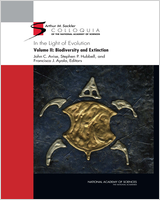NCBI Bookshelf. A service of the National Library of Medicine, National Institutes of Health.
The current extinction crisis is of human making, and any favorable resolution of that biodiversity crisis--among the most dire in the 4-billion-year history of Earth--will have to be initiated by mankind. Little time remains for the public, corporations, and governments to awaken to the magnitude of what is at stake. This book aims to assist that critical educational mission, synthesizing recent scientific information and ideas about threats to biodiversity in the past, present, and projected future.
This is the second volume from the In the Light of Evolution series, based on a series of Arthur M. Sackler colloquia, and designed to promote the evolutionary sciences. Each installment explores evolutionary perspectives on a particular biological topic that is scientifically intriguing but also has special relevance to contemporary societal issues or challenges. Individually and collectively, the ILE series aims to interpret phenomena in various areas of biology through the lens of evolution, address some of the most intellectually engaging as well as pragmatically important societal issues of our times, and foster a greater appreciation of evolutionary biology as a consolidating foundation for the life sciences.
Contents
- THE NATIONAL ACADEMIES
- Arthur M. Sackler, M.D. 1913-1987
- Preface to the In the Light of Evolution Series
- Preface to In the Light of Evolution, Volume II: Biodiversity and Extinction
- Part I. CONTEMPORARY PATTERNS AND PROCESSES IN ANIMALS
- 1. Ecological Extinction and Evolution in the Brave New Ocean
- 2. Are We in the Midst of the Sixth Mass Extinction? A View from the World of Amphibians
- 3. Patterns of Biodiversity and Endemism on Indo-West Pacific Coral Reefs
- 4. Homage to Linnaeus: How Many Parasites? How Many Hosts?
- HOW MANY SPECIES ARE THERE ON EARTH?
- HOW MANY PARASITE SPECIES?
- HOW MANY PARASITE SPECIES PER HOST SPECIES?
- HOW MANY PARASITES AND WHAT IS THEIR ROLE IN AN ECOLOGICAL FOOD WEB?
- HOW RAPIDLY ARE WE LOSING HOSTS AND PARASITES?
- WHERE DO AVIAN HOSTS OCCUR?
- LOSS OF AVIAN DIVERSITY: CLIMATE CHANGE VERSUS HABITAT LOSS
- HOW MANY BIRD PARASITES HAVE WE LOST?
- ECOSYSTEMS SERVICES LOST?
- REGULATION OF HOST POPULATIONS AND RELATIVE ABUNDANCE IN COMMUNITIES
- REGULATION OF CONCENTRATION OF POLLUTANTS
- ACKNOWLEDGMENTS
- Part II. CONTEMPORARY PATTERNS AND PROCESSES IN PLANTS AND MICROBES
- 5. Species Invasions and Extinction: The Future of Native Biodiversity on Islands
- 6. How Many Tree Species Are There in the Amazon and How Many of Them Will Go Extinct?
- 7. Microbes on Mountainsides: Contrasting Elevational Patterns of Bacterial and Plant Diversity
- 8. Resistance, Resilience, and Redundancy in Microbial Communities
- Part III. TRENDS AND PROCESSES IN THE PALEONTOLOGICAL PAST
- Part IV. PROSPECTS FOR THE FUTURE
- 13. A Phylogenetic Perspective on the Distribution of Plant Diversity
- 14. Phylogenetic Trees and the Future of Mammalian Biodiversity
- 15. Three Ambitious (and Rather Unorthodox) Assignments for the Field of Biodiversity Genetics
- 16. Engaging the Public in Biodiversity Issues
- 17. Further Engaging the Public on Biodiversity Issues
- 18. Where Does Biodiversity Go from Here? A Grim Business-as-Usual Forecast and a Hopeful Portfolio of Partial Solutions
- References
This volume is based on the Arthur M. Sackler Colloquium of the National Academy of Sciences, “In the Light of Evolution II: Biodiversity and Extinction,” held December 7-8, 2007, at the Arnold and Mabel Beckman Center of the National Academies of Sciences and Engineering in Irvine, California. The articles appearing in these pages were contributed by speakers at the colloquium and have been anonymously reviewed. Any opinions, findings, conclusions, or recommendations expressed in this volume are those of the authors and do not necessarily reflect the view of the National Academy of Sciences.
- NLM CatalogRelated NLM Catalog Entries
- Review In the Light of Evolution: Volume IV: The Human Condition[ 2010]Review In the Light of Evolution: Volume IV: The Human ConditionNational Academy of Sciences (US), Avise JC, Ayala FJ. 2010
- Review In the Light of Evolution: Volume III: Two Centuries of Darwin[ 2009]Review In the Light of Evolution: Volume III: Two Centuries of DarwinNational Academy of Sciences (US), Avise JC, Ayala FJ. 2009
- Review In the Light of Evolution: Volume VI: Brain and Behavior[ 2013]Review In the Light of Evolution: Volume VI: Brain and BehaviorStriedter GF, Avise JC, Ayala FJ, National Academy of Sciences. 2013 Jan 25
- Is evolutionary biology strategic science?[Evolution. 2007]Is evolutionary biology strategic science?Meagher TR. Evolution. 2007 Jan; 61(1):239-44.
- In the Light of Evolution II: Biodiversity and Extinction. Proceedings of the Arthur M. Sackler Colloquium of the National Academy of Sciences. December 6-8, 2007. Irvine, California, USA.[Proc Natl Acad Sci U S A. 2008]In the Light of Evolution II: Biodiversity and Extinction. Proceedings of the Arthur M. Sackler Colloquium of the National Academy of Sciences. December 6-8, 2007. Irvine, California, USA.Avise JC, Hubbell SP, Ayala FJ. Proc Natl Acad Sci U S A. 2008 Aug 12; 105 Suppl 1(Suppl 1):11453-586.
- In the Light of EvolutionIn the Light of Evolution
- Results relating to occupancy levels in waiting bays while a decision to allocat...Results relating to occupancy levels in waiting bays while a decision to allocate to a SARS-CoV-2-infected bay or a non-SARS-CoV-2-infected bay is being made - Modelling of hypothetical SARS-CoV-2 point-of-care tests on admission to hospital from A&E: rapid cost-effectiveness analysis
- CD177 [Neofelis nebulosa]CD177 [Neofelis nebulosa]Gene ID:131500414Gene
Your browsing activity is empty.
Activity recording is turned off.
See more...
